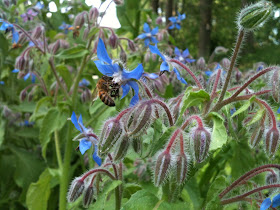How do we define excess honey? Do bees even make excess honey? I'm sure this highly evolved super organism (Bien) is never doing more than they need, but once placed inside a man made beehive all of this changes since we all manipulate bees, more or less, but nonetheless.
Research done by Dr. Seeley shows that feral swarms prefer cavities of 40 liters when given to choose between 15, 40, 60 and 100 liters cavities. Most beehives are much bigger than 40 liters, exception is skeps.
So what does a bee colony do once they have filled the whole 40 liters cavity? Since they need no extra honey once all comb is filled in Summer, what other tasks do they perform? So many bees must be doing something. In two of my hives the bees have filled all the combs with nectar including the brood nest and the Queen has ceased to lay new eggs. Why this break in brood raising?
Is it possible that all these vacant bees take on a new task, like grooming one another because that is the very thing I observed in one of my hives with an observation window. I don't know, but what I know for sure is that the colony is preserving energy which brood raising requires. Fact is that flying forager bees live no longer that 6 weeks because of all the foraging work. Is it possible that worker bees live longer when not flying? If all the cobs are full there is no need to fly and hence the body is not worked to death.
We beekeepers try every kind of manipulation to get them make as much honey for us as possible; some do supering, others nadiring, some checkerboarding, and those with horizontal Top Bar Hives spacing.
Would bees do better is we would stop manipulating them?
I decided to start harvesting what I see as excess honey and that is all the comb behind the 10th comb counting from the entrance. Most beekeepers around here overwinter bees on 10 frames which hold 2 kg of stores each, so 20 kg for a Buckfast bee. Nordic Bee needs less.
I have not yet poured the honey into jars so not sure how much honey I harvested from this one colony but I'm assuming around 2-3 kg honey.
I used a honey press which I've got as a present from my parents-in-law.





























